If I could do only one pose for the rest of my life it would be this core twist – jathara parivartanasana. This amazing shape covers everything in one pose – the inner thighs, the shoulder girdle, the tensor fasciae latae (TFL) and glutes, and most importantly, the abdominal muscles.
If I could do only one pose for the rest of my life it would be this core twist – jathara parivartanasana. This amazing shape covers everything in one pose – the inner thighs, the shoulder girdle, the tensor fasciae latae (TFL) and glutes, and most importantly, the abdominal muscles.
When I first learned this pose the teacher announced, “If you can do five sets of twenty reps, you can do anything in yoga.” Going home with grit and determination, it took me three months to get one set of twenty down, and I have to admit I stopped there. But that set of twenty is pretty fierce in its own right.
This core twist is simply a beast of an exercise. I’m going to give you two variations and four different props that you can use to make things easier. I will break it down piece by piece using instructions, photos, and a video.
The Muscle Groups Involved: Abdominals
Of the four sets of abdominal muscles – internal and external obliques, transverse abdominis, and rectus abdominis – the core twist mostly works the obliques. The obliques both flex and rotate the spine and get worked through all of the actions in this exercise.
The transverse abdominis is involved quite a bit to stabilize the lumbar spine, while the rectus abdominis works least, though it is essential to helping the feet move towards the hands.
The Muscle Groups Involved: The Rotator Cuff
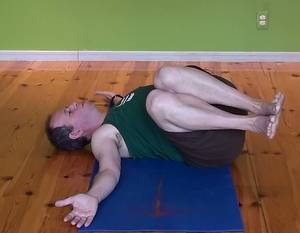
Another set of four muscles – infraspinatus, supraspinatus, teres minor, and subscapularis – get a phenomenal workout here, as long as you resist the urge to let the shoulders lift off of the floor.
There are few better ways to strengthen the stubborn and troubling muscles of the rotator cuff than maintaining the shoulders on the mat as you move the legs from side to side. Thus, the legs should only go as far as the shoulders can stay down.
The Muscle Groups Involved: The Adductors
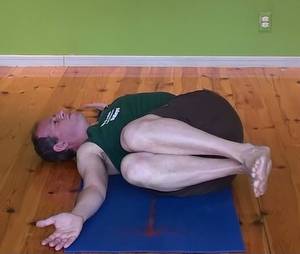
There are five in this group – adductors brevis, magnus, longus, pectineus, and gracilis. These are the muscles I watch most when teaching this core twist. The legs don’t often want to stay together.
Weakness in this muscle group or tightness in the outer thighs will conspire to pull the legs apart. The goal in this movement is to keep them together at all costs. Two of the prop options I will explain a little later are helpful for that.
The Muscle Groups Involved: Gluteus Maximus, Hamstrings and the Tensor Fasciae Latae
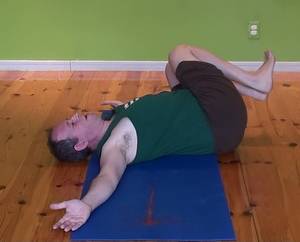
The last muscles to look are the tensor fasciae latae (TFL) versus the gluteus maximus and the hamstrings. The angle of the legs as they transition from side to side determines the muscles you will use to accomplish the action.
We want the TFL to be in play in this pose as the knees or feet angle up towards the arms. If the knees and legs are pulled away from the arms this is the result of tight or overly strong gluteal muscles and hamstrings preventing the TFL from working as well as it could. If you feel that this is happening, you need to stick with the bent-knee variation.
Core Twist (Jathara Parivartanasana) Variations
Prop Options:
- Put a blanket or block between the inner thighs.
- Belt the legs together at the middle of the thighs.
- Have your friend hold down your shoulders.
- Hold onto a heavy couch or desk leg with your hands.
Variation #1 Knees Bent
This is the variation pictured above and the best place to start, especially if you have tight hamstrings.
- Start lying on your back with the knees bent and the feet flat to the floor.
- Open your arms out to the side with the wrists in line with the shoulders.
- With the legs together and the knees bent, bring them up towards the chest.
- Keeping the left shoulder down draw the knees to the right towards the elbow.
- Making sure to keep the legs together do your best to point the knees up towards the nose as you come back up. Watch out that you don’t round your lower back but keep it neutral.
- Keep the right shoulder down as you move the knees to the left trying to point them up towards the elbow.
- Even if you are able to keep the shoulders grounded don’t take the knees all the way down. Hover the knees an inch or two off of the floor.
Variation #2 Legs Straight
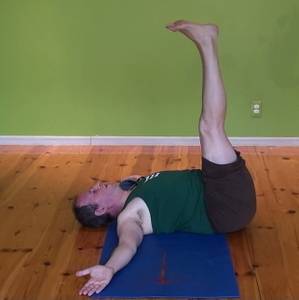
The ability to do this version of the pose requires long hamstrings and happy gluteus maximus. If the hamstrings are tight, the straight legs will be pulled away from the arms. The legs need to be able to move up towards the hands.
If the straight legs can’t move up towards the fingertips, it is best to keep working with the knees bent.
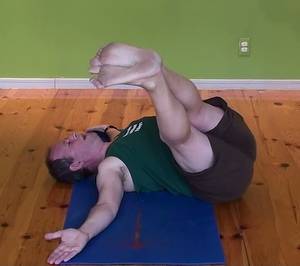
- Start lying on your back with the legs extended.
- Open your arms out to the side with the wrists in line with the shoulders.
- Start by bringing one leg up to ninety degrees. Bring the second leg up to meet it. Flex the feet.
- Keeping the left shoulder down lower the legs to the right with the toes pointing towards the fingertips.
- A lot of the work is in keeping the legs and feet together as you lift back up to the midline.
- Again, try to point the toes towards the nose as you come back up rather than let the legs fall away from you. If the legs pull away be willing to bend the knees and continue with variation number one.
- Keep the right shoulder down as you move the legs to the left trying to pull them up towards the elbow.
- It is much harder to keep the shoulders down with the legs straight and you might only go a foot or two to the side.
- But even if you are able to keep the shoulders on the mat don’t take the legs all the way down. Hover the legs an inch or two off of the floor before bringing the legs back up.
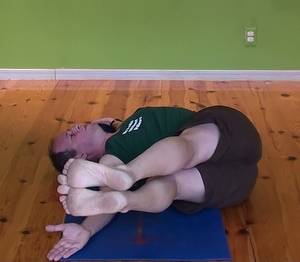
Whichever variation you are doing, try to start with a set of five working to ten and ultimately to twenty.
If you want to do every yoga pose of your dreams, follow my teacher’s advice and build up to five sets of twenty.
This is truly a full-body pose. In addition to the strengthening of the core, shoulder, and legs, another benefit of this exercise is the detoxification of the internal organs – liver, spleen, and intestines – and providing great aid in the alleviation of lower back pain.






